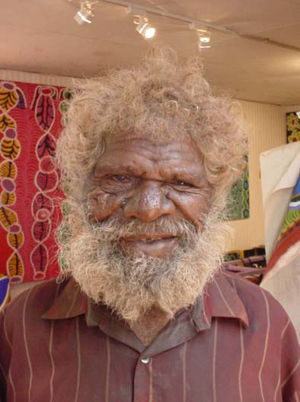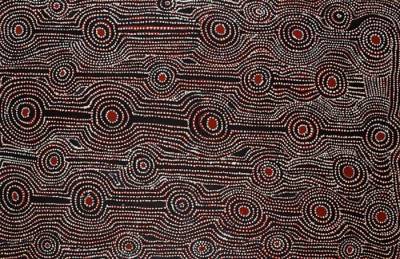Hector came out of the desert into Pukatja (Ernabella) as a child with his parents.
He worked as a 'ringer' or cattleman at Curtin Springs Station, approximately 130km north of Amata.
While still a young man in Pukatja he met Naomi Kantjuri (also a painter with Tjala Arts) whom he married., They moved to Amata so Hector could work on the dams out near Wingellina as well as build and repair fences.
He was 'Leading Hand' during the construction of the cattle yards just outside of Amata and returned to Pukatja to build the “big barn”.
Hector tells the story of when he was a young fella catching the old Ghan train from Oodnadatta, down to Adelaide to pick fruit.
He said "his tjitji' (children) were babies, only crawling." As an elder, Hector is revered as a caretaker of Anangu law and culture.
He is one of the few remaining elders that still have strong ties to traditional practices.
This is demonstrated by the images he paints - his Creation story of the Anumara or edible caterpillar.
Hector started painting in October 2003 after the men’s painting room was established to encourage the men of Amata to tell their stories on canvas.
Hector had never painted using canvas and acrylics before coming to Tjala Arts (formerly Minymaku Arts).
His first exhibtion at Alcaston Gallery in 2004 was an instant sell-out.
.Hector came out of the desert into Pukatja (Ernabella) as a child with his parents.
He worked as a 'ringer' or cattleman at Curtin Springs Station, approximately 130km north of Amata.
While still a young man in Pukatja he met Naomi Kantjuri (also a painter with Tjala Arts) whom he married., They moved to Amata so Hector could work on the dams out near Wingellina as well as build and repair fences.
He was 'Leading Hand' during the construction of the cattle yards just outside of Amata and returned to Pukatja to build the “big barn”.
Hector tells the story of when he was a young fella catching the old Ghan train from Oodnadatta, down to Adelaide to pick fruit.
He said "his tjitji' (children) were babies, only crawling." As an elder, Hector is revered as a caretaker of Anangu law and culture.
He is one of the few remaining elders that still have strong ties to traditional practices.
This is demonstrated by the images he paints - his Creation story of the Anumara or edible caterpillar.
Hector started painting in October 2003 after the men’s painting room was established to encourage the men of Amata to tell their stories on canvas.
Hector had never painted using canvas and acrylics before coming to Tjala Arts (formerly Minymaku Arts).
His first exhibtion at Alcaston Gallery in 2004 was an instant sell-out.
.![Australian Indigenous (Aboriginal and Torres Strait Islander) artwork by HECTOR TJUPURU BURTON of Tjala Artists. The title is Anumara Tjukurpa. [550-07] (Acrylic on Linen)](https://media.redotgallery.com/stockroom/gallery/a/anumara-tjukurpa-2274.jpg)
![Australian Indigenous (Aboriginal and Torres Strait Islander) artwork by HECTOR TJUPURU BURTON of Tjala Artists. The title is Anumara Tjukurpa. [1012-06] (Acrylic on Linen)](https://media.redotgallery.com/stockroom/gallery/a/anumara-tjukurpa-80.jpg)

